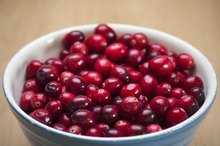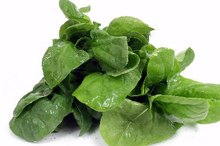What does fact checked mean?
At Healthfully, we strive to deliver objective content that is accurate and up-to-date. Our team periodically reviews articles in order to ensure content quality. The sources cited below consist of evidence from peer-reviewed journals, prominent medical organizations, academic associations, and government data.
- MayoClinic.com; Folic Acid; Feb. 2011
- National Institutes of Health: Folate; April 2009
- OSU: Folic Acid; Jane Higdon, Ph.D., April 2002
The information contained on this site is for informational purposes only, and should not be used as a substitute for the advice of a professional health care provider. Please check with the appropriate physician regarding health questions and concerns. Although we strive to deliver accurate and up-to-date information, no guarantee to that effect is made.
Citrus Fruits Containing Folic Acid
Folic acid and folate are terms that are often used interchangeably. Folic acid is the synthetic form of folate, a B vitamin that occurs naturally in some foods. Necessary for cell production and growth, folate helps produce DNA and prevents certain serious birth defects including spina bifida. It also plays a role in anemia prevention because it promotes the production of red blood cells in both adults and children. Many foods, like cereals and baked goods, are fortified with folic acid; however, folate occurs naturally in citrus fruits.
Folate Intake
Recommended dietary guidelines for folate vary depending on your age and if you are pregnant or lactating. Infants up to 6 months of age should get approximately 65 micrograms of folate per day, whereas infants 7 to 12 months need about 80 micrograms per day. For children ages 1 to 3, the recommendation is 150 micrograms per day, while ages 4 to 8 need 200 micrograms per day, and ages 9 to 13 need 300 micrograms per day. Adolescents ranging in age from 14 to 19 should aim for about 400 micrograms of folate each day. Pregnant women need 600 micrograms per day.
- Recommended dietary guidelines for folate vary depending on your age and if you are pregnant or lactating.
- For children ages 1 to 3, the recommendation is 150 micrograms per day, while ages 4 to 8 need 200 micrograms per day, and ages 9 to 13 need 300 micrograms per day.
Grapefruit
What Vitamins Do Mangoes Have?
Learn More
One type of citrus fruit that can provide you with folate is grapefruit. The amount of folate found in one Florida grapefruit is about 22 micrograms. However, other kinds of grapefruits like those harvested in California and Arizona contain close to 10 micrograms more. You can also get folate from drinking grapefruit juice, which has about 25 micrograms in 1 cup.
- One type of citrus fruit that can provide you with folate is grapefruit.
- The amount of folate found in one Florida grapefruit is about 22 micrograms.
Lemons and Limes
According to the United States Department of Agriculture 1 cup of lemons provides you with about 23 micrograms of folate, while 1 cup of lemon juice contains about 24 micrograms. Similarly, limes are also a type of citrus fruit that contain folate 3. One cup of lime juice provides you with about 20 micrograms of folate.
Oranges and Tangerines
Fruits That Do Not Contain Folate
Learn More
You can get approximately 8 percent of your daily value for folate by eating one small orange, as it provides you with about 30 micrograms. A serving of orange juice contains even more -- about 75 micrograms in a 6 oz. glass. Oranges also provide you with many other vitamins and minerals including vitamin C. Also part of the citrus fruit family, tangerines are a type of mandarin orange that contain folate, with about 19 micrograms in one large tangerine.
- You can get approximately 8 percent of your daily value for folate by eating one small orange, as it provides you with about 30 micrograms.
Related Articles
References
- MayoClinic.com; Folic Acid; Feb. 2011
- National Institutes of Health: Folate; April 2009
- FAO: Nutritional and Health Benefits of Citrus Fruits; C. Economos and W.D. Clay
- OSU: Folic Acid; Jane Higdon, Ph.D., April 2002
- USDA: Nutrient Data Laboratory
- Feng Y, Wang S, Chen R, Tong X, Wu Z, Mo X. Maternal folic acid supplementation and the risk of congenital heart defects in offspring: a meta-analysis of epidemiological observational studies. Sci Rep. 2015;5:8506. doi:10.1038/srep08506
- Khan KM, Jialal I. Folic acid (folate) deficiency. In: StatPearls. Updated December 3, 2019.
- Obeid R, Herrmann W. The emerging role of unmetabolized folic acid in human diseases: myth or reality?. Curr Drug Metab. 2012;13(8):1184-95. doi:10.2174/138920012802850137
- Xun P, Liu K, Loria CM, et al. Folate intake and incidence of hypertension among American young adults: a 20-y follow-up study. The American Journal of Clinical Nutrition. 2012;95(5):1023-1030. doi:10.3945/ajcn.111.027250
- Williams J, Mai CT, Mulinare J, et al. Updated estimates of neural tube defects prevented by mandatory folic Acid fortification - United States, 1995-2011. MMWR Morb Mortal Wkly Rep. 2015;64(1):1–5.
- Huang P, Wang F, Sah BK, et al. Homocysteine and the risk of age-related macular degeneration: a systematic review and meta-analysis. Sci Rep. 2015;5:10585. doi:10.1038/srep10585
- Christen WG, Glynn RJ, Chew EY, Albert CM, Manson JE. Folic acid, pyridoxine, and cyanocobalamin combination treatment and age-related macular degeneration in women: the Women's Antioxidant and Folic Acid Cardiovascular Study. Arch Intern Med. 2009;169(4):335-41. doi:10.1001/archinternmed.2008.574
- Pieroth R, Paver S, Day S, Lammersfeld C. Folate and its impact on cancer risk. Curr Nutr Rep. 2018;7(3):70–84. doi:10.1007/s13668-018-0237-y
- Atta, C.; Fiest, K.; Frolkis, A. et al. Global Birth Prevalence of Spina Bifida by Folic Acid Fortification Status: A Systematic Review and Meta-Analysis. Am J Public Health. 2016 Jan;106(1):e24-34. DOI: 10.2105/AJPH.2015.302902.
- Chen, P.; Li, C.; Li, X. et al. Higher dietary folate intake reduces the breast cancer risk: a systematic review and meta-analysis. Br J Cancer. 2014 Apr 29;110(9):2327-38. DOI: 10.1038/bjc.2014.155.
- Cui, R.; Iso, H.; Date, C. et al. Dietary folate and vitamin b6 and B12 intake in relation to mortality from cardiovascular diseases: Japan collaborative cohort study. Stroke. 2010 Jun;41(6):1285-9. DOI: 10.1161/STROKEAHA.110.578906.
- Gopinath, B.; Flood, V.; Rochtchina, E. et al. Homocysteine, folate, vitamin B-12, and 10-y incidence of age-related macular degeneration. Am J Clin Nutr. 2013 Jul;98(1):129-35. DOI: 10.3945/ajcn.112.057091.
Writer Bio
Lindsay Gulla started writing professionally in 2011. She is a health coach for a leading wellness company. Gulla holds a Master of Science in community health from Old Dominion University and a Bachelor of Science in health communication from James Madison University.









